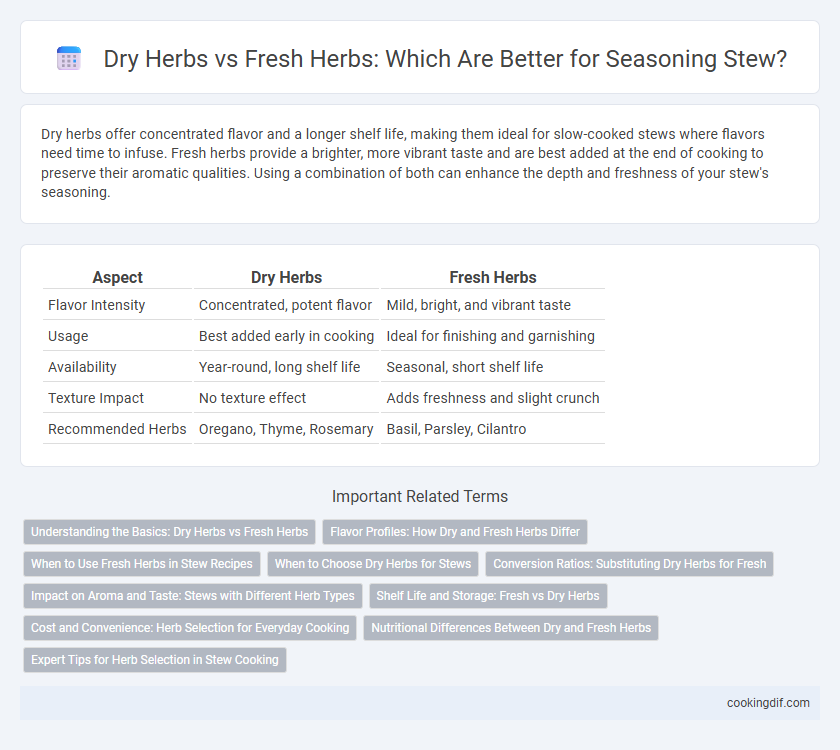Dry herbs offer concentrated flavor and a longer shelf life, making them ideal for slow-cooked stews where flavors need time to infuse. Fresh herbs provide a brighter, more vibrant taste and are best added at the end of cooking to preserve their aromatic qualities. Using a combination of both can enhance the depth and freshness of your stew's seasoning.
Table of Comparison
| Aspect | Dry Herbs | Fresh Herbs |
|---|---|---|
| Flavor Intensity | Concentrated, potent flavor | Mild, bright, and vibrant taste |
| Usage | Best added early in cooking | Ideal for finishing and garnishing |
| Availability | Year-round, long shelf life | Seasonal, short shelf life |
| Texture Impact | No texture effect | Adds freshness and slight crunch |
| Recommended Herbs | Oregano, Thyme, Rosemary | Basil, Parsley, Cilantro |
Understanding the Basics: Dry Herbs vs Fresh Herbs
Dry herbs offer concentrated flavors and a longer shelf life, making them ideal for slow-cooked stews where their essence fully infuses the dish. Fresh herbs provide bright, vibrant notes and are best added towards the end of cooking to preserve their aroma and color. Using the right form of herbs based on cooking time ensures optimal flavor balance in your stew.
Flavor Profiles: How Dry and Fresh Herbs Differ
Dry herbs concentrate flavor by removing moisture, resulting in a more potent and intense taste, ideal for long-cooking stews where gradual flavor release is essential. Fresh herbs offer brighter, more vibrant notes with subtle complexities, best added toward the end of cooking to preserve their aromatic qualities. The choice between dry and fresh herbs significantly impacts the stew's overall flavor profile, balancing depth with freshness.
When to Use Fresh Herbs in Stew Recipes
Fresh herbs, such as parsley, basil, and cilantro, are best used in stew recipes when added at the end of cooking or as a garnish to preserve their vibrant flavor and aroma. Incorporating fresh herbs towards the final minutes prevents the loss of essential oils that occur during prolonged heat exposure, ensuring a bright and fresh herbal note. This technique enhances the depth and complexity of the stew without overpowering the dish with bitter or muted flavors.
When to Choose Dry Herbs for Stews
Dry herbs release concentrated flavors slowly, making them ideal for long-simmering stews where extended cooking time enhances their potency. Use dry herbs such as thyme, oregano, or bay leaves at the beginning of the cooking process to infuse deep, robust aromas without overpowering the dish. Their low moisture content ensures consistent seasoning and preserves flavor during prolonged heat exposure in stews.
Conversion Ratios: Substituting Dry Herbs for Fresh
When substituting dry herbs for fresh in stew recipes, use one-third the amount of dry herbs since drying concentrates their flavor. For example, replace 1 tablespoon of fresh herbs with 1 teaspoon of dry herbs to maintain balanced seasoning. Adjust according to personal taste and the herb's potency, as some herbs lose intensity during drying.
Impact on Aroma and Taste: Stews with Different Herb Types
Dry herbs release a concentrated, intense aroma when simmered in stews, enhancing depth with a slightly muted freshness compared to fresh herbs. Fresh herbs contribute bright, vibrant flavors and aromatic oils that infuse stews late in cooking for a more pronounced, lively taste. The choice between dry and fresh herbs significantly affects the stew's overall flavor profile, with dry herbs providing a robust base and fresh herbs offering a fresh, fragrant finish.
Shelf Life and Storage: Fresh vs Dry Herbs
Dry herbs have a significantly longer shelf life compared to fresh herbs, typically lasting up to a year when stored in a cool, dark place, while fresh herbs usually remain potent for only about one to two weeks when refrigerated. Proper storage of fresh herbs involves wrapping them in damp paper towels and placing them in an airtight container to extend freshness, whereas dry herbs should be kept in airtight containers away from direct sunlight and humidity to preserve their flavor and potency. The choice between fresh and dry herbs depends on the desired flavor intensity and convenience, with dry herbs offering long-term usability and fresh herbs providing vibrant, aromatic seasoning.
Cost and Convenience: Herb Selection for Everyday Cooking
Dry herbs offer a cost-effective option for seasoning stew, as they have a longer shelf life and require no refrigeration, making them convenient for everyday cooking. Fresh herbs provide vibrant flavors but tend to be more expensive and spoil quickly, limiting their use to short-term meal prep. Choosing between dry and fresh herbs depends on the balance between budget constraints and the desired intensity of herbaceous notes in a stew.
Nutritional Differences Between Dry and Fresh Herbs
Dry herbs contain a higher concentration of nutrients per gram due to moisture removal, which intensifies flavors and preserves antioxidants like flavonoids and phenolic acids. Fresh herbs retain more volatile oils and vitamin C, contributing to their bright aroma and potential immune-boosting properties, but they are less nutrient-dense by weight compared to dried herbs. Choosing between dry and fresh herbs for seasoning depends on desired flavor intensity and specific nutritional benefits, with dry herbs offering prolonged shelf life and fresh herbs providing fresher, subtle nuances.
Expert Tips for Herb Selection in Stew Cooking
Dry herbs concentrate flavors and provide consistent seasoning throughout long simmering times in stew, while fresh herbs offer vibrant, bright notes best added near the end of cooking to preserve their aroma. Expert chefs recommend using dry herbs like thyme, rosemary, and bay leaves during the initial cooking stages to infuse deep, layered flavors, complementing fresh herbs such as parsley, cilantro, or basil as a final garnish for a fresh finish. Balancing the intensity and timing of both dry and fresh herbs enhances complexity and elevates the overall taste profile of rich stews.
Dry herbs vs fresh herbs for seasoning Infographic

 cookingdif.com
cookingdif.com